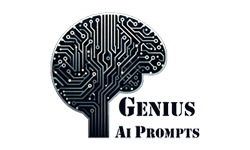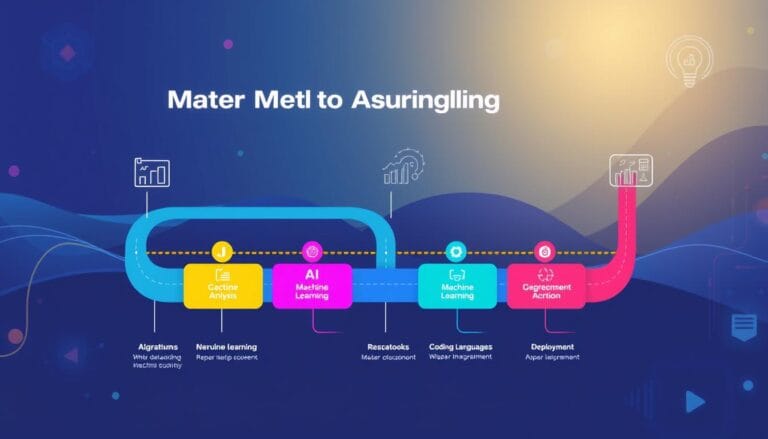Beginner AI Coding Projects: Easy Start for AI Enthusiasts
The AI industry is growing fast, expected to hit $126 billion by 2025. Big names like IBM, Accenture, and Apple are looking for AI experts. In 2021, AI engineers made a median salary of $171,715, with some earning over $250,000. This shows how crucial it is to learn AI skills to stand out in the job market.
Thank you for reading this post, don't forget to subscribe!If you’re new to coding or already skilled, this article will guide you. We’ll explore Beginner AI Coding Projects to start your career. By working on these projects, you’ll improve your skills and show employers what you can do.
Table of Contents
Key Takeaways
- The AI industry is predicted to reach $126 billion by 2025, with high-paying job opportunities for skilled practitioners.
- Beginner-level AI projects can help you develop practical skills and showcase your abilities to potential employers.
- AI projects can cover a wide range of applications, from text-based tasks to image processing and simple machine learning.
- Building an AI chatbot, exploring natural language processing, and working with computer vision can further enhance your AI portfolio.
- Leveraging AI APIs and cloud services can simplify the development process and expose you to industry-standard tools and practices.
Understanding AI and Machine Learning Fundamentals
Artificial intelligence (AI) has changed how we use technology. It lets machines think like humans for tasks like making decisions and recognizing speech. At the core of AI is machine learning (ML), which helps machines learn from data and make choices without being told how.
Key Components of AI Systems
The main parts of AI and ML systems are:
- Data: The raw information, such as numbers, images, or text, that the system uses to learn and make predictions.
- Algorithms: The instructions that guide the machine learning process, enabling the system to analyze data and identify patterns.
- Models: The output of the training process, which can be used to make predictions or decisions on new data.
- Training and testing: The iterative process of feeding data into the algorithms, adjusting the models, and evaluating their performance.
Essential Programming Concepts for AI
To build AI and ML systems, you need to know programming well. You should be good with languages like Python. You also need to know about data structures, algorithms, and math like linear algebra and calculus.
Popular AI Libraries and Frameworks
The AI and ML world has many open-source libraries and frameworks. They make building AI easier. TensorFlow, PyTorch, and scikit-learn are some of the most used. They offer pre-built functions, speed up training, and help add AI to different apps.
Learning about AI fundamentals, machine learning basics, and AI components opens doors. It lets you create smart systems that solve big problems and bring new ideas to many fields.
Setting Up Your AI Development Environment
Starting your AI journey means setting up a strong coding environment. You’ll need to know the key tools and libraries for AI and machine learning (ML).
First, learn the basics of Python, the top language for AI. Python is easy to read and has a huge library, making it great for all levels. You’ll also want to check out Pandas for data, NumPy for numbers, and Matplotlib or Seaborn for visuals.
It’s also important to understand the math behind AI and ML. This includes linear algebra, statistics, and calculus. Knowing these basics will help you understand AI models and algorithms.
- Look into machine learning libraries like scikit-learn for easy projects and TensorFlow or PyTorch for harder tasks.
- Use cloud-based GPU solutions, like DigitalOcean’s GPU Droplets, to grow your AI/ML work without big hardware costs.
- Try interactive coding spaces like Jupyter Notebook or Google Colab for easy AI and ML testing.
With a good AI setup, you’re ready to start on beginner AI coding projects. You’ll improve your skills in this exciting field.
“Laying the groundwork for your AI development setup is crucial for ensuring the success of your projects and unlocking your full potential as an AI engineer.”
Getting Started with Python for AI Development
Python is now the top choice for AI and machine learning. It’s easy to use, has a huge library, and lots of community support. If you’re new to AI, starting with Python is a great idea.
Installing Required Libraries
To start with Python for AI, you need to install some key libraries. Here are the most important ones:
- NumPy – Essential for scientific computing, it handles large arrays and matrices. It also has many mathematical functions.
- Pandas – Great for data manipulation and analysis. It works with structured and time series data.
- Matplotlib – Perfect for making static, animated, and interactive visuals in Python.
- Scikit-learn – Offers tools for data mining and analysis. It includes algorithms for classification, regression, and clustering.
Basic Python Syntax for AI
Knowing Python’s basic syntax is key for AI development. Python is easy to read and write, making it great for beginners. You should learn about variables, data types, functions, and control structures.
Data Handling in Python
Data handling is crucial for AI. Python’s Pandas library is powerful for data manipulation and cleaning. These steps are vital in AI development. Learning to load, filter, transform, and visualize data will help you succeed in AI projects.
By installing libraries, learning Python basics, and improving data handling, you’re ready to use Python for AI development. With these skills, you can dive into more advanced AI topics and create your own intelligent apps.
Essential Tools and Resources for AI Projects
Starting your AI journey? You’ll find many tools and resources to help you. From open-source datasets to places to work together, the AI world has a lot to offer. It’s a great place to start your projects.
For AI projects, datasets from sites like Kaggle or the UCI Machine Learning Repository are key. They have lots of data in different areas. This lets you work with real data and improve your AI skills.
Platforms like Stack Overflow, Reddit (r/MachineLearning), and GitHub are also crucial. They’re full of people who can help, work together, and share AI projects. It’s a supportive and lively community.
Need powerful computers for AI? Cloud-based GPU solutions like DigitalOcean’s GPU Droplets are a good choice. They’re affordable and can handle big AI tasks.
| AI Tool | Description | Pricing |
|---|---|---|
| Tabnine | AI-powered code completion tool used by leading tech companies | Paid plans starting from $12/month per seat |
| CodeT5 | Open-source AI code generator supporting various programming languages | Free version available |
| WPCode | AI-driven WordPress code generator | Paid plans starting from $49 |
| AskCodi | AI-powered development tools for writing better and shorter code | Paid plans starting from $7.99/month per seat |
These are just a few examples of the many AI tools out there. Whether you’re new or experienced, keep exploring. As you tackle AI-generated coding challenges, use these resources to get better and work more efficiently.
Beginner AI Coding Projects
Starting your AI journey can be exciting. You can begin with many coding projects that will grow your skills and spark your interest. These projects cover text, images, and simple machine learning, offering something for everyone.
Text-Based Projects
One great project for beginners is making a resume parser with NLP. Use NLTK to clean the text and then group skills and experiences with clustering algorithms. You can also try making a fake news detector with the BERT model for text classification.
Image Processing Projects
If you like working with images, try building an object detection system. Use OpenCV to find and classify objects in images. You can also explore facial recognition or image segmentation.
Simple Machine Learning Applications
Start with machine learning by predicting house prices with linear regression or making a movie recommender. These projects teach you the basics of machine learning and help you solve real problems.
Remember, learning AI is best done by doing. Be open to trying new AI project ideas and beginner projects. With hard work and curiosity, you’ll master machine learning applications in no time.
“The future of humanity is going to be radically different because of AI.” – Yuval Noah Harari
Building Your First AI Chatbot
Creating your own AI chatbot is a great way to start. It lets you explore natural language processing (NLP) and machine learning. You can use libraries like TensorFlow or platforms like Dialogflow to get started.
As a beginner, you can pick from many conversational AI ideas. You could make a chatbot from podcast transcripts, a fitness coach, or a local info chatbot. These projects will teach you Python, NLP, and more.
To start, learn the basics of AI and machine learning. Also, learn about programming and chatbot frameworks. Once you master these, you can create your first AI chatbot.
| Chatbot Building Statistics | Value |
|---|---|
| Training options | Scan a full page, scan only nested pages, or scan a single page |
| Automatically generated or manually added skills | Contact us, FAQ, About, Pricing |
| Automatically collected attributes | Company name, address, URLs to privacy policy and terms, social media links |
| Testing tool | Simulate customer interactions within the ChatBot web app |
| AI Assist model | In-house AI model trained on initial data sources like website URLs or help centers |
| Customizable Chat Widget settings | Bot name, description, avatar, language, welcome screen, theme, color, background image, greetings |
| Greetings personalization | Based on user behavior or time spent on specific pages |
| Chatbot version history | Track changes and updates under the Version History icon |
| Chat Widget installation | Copy a code snippet and paste it onto the website |
Use Retrieval-Augmented Generation (RAG) and LangChain to improve your chatbot. These tools mix information retrieval with LLMs for better text output. They make building AI apps easier and more flexible.
Remember, making a great AI chatbot takes testing and improvement. Keep working on it to make it better and more user-friendly.
Natural Language Processing Projects for Beginners
If you’re curious about Artificial Intelligence (AI) and Machine Learning (ML), NLP projects are a great place to start. NLP deals with how computers understand and work with human language. You can try out fun projects like sentiment analysis, text classification, and language translation.
Sentiment Analysis Tools
Sentiment analysis is a cool NLP project for beginners. It uses machine learning to find the emotions in text. This is useful for checking social media, product reviews, or customer feedback. You can make a tool that automatically says if text is positive, negative, or neutral.
Text Classification Systems
Text classification is another fun project. It trains a model to sort text into different groups. For example, you can use it to catch spam messages. You can use algorithms like SVMs or deep learning models like CNNs or RNNs for this.
Language Translation Applications
Language translation is also a great area for beginners. You can make a simple app that translates text between languages. You can use NMT or transformer models for this. You can also use APIs like Google Translate or DeepL to improve your app.
Working on these NLP projects will teach you programming and machine learning skills. You’ll also get to apply AI and ML to real problems. As you get better, you can tackle more complex NLP topics. Showcasing your work in a portfolio can impress employers or clients.
Computer Vision Projects to Enhance Your Portfolio
Start your journey in computer vision and boost your portfolio with exciting projects. This field of AI has changed many industries. It’s used for reverse engineering, security checks, and even in image editing and self-driving cars.
Begin with simple projects that take a few hours to a couple of days. Try image classification with models like MobileNet or ResNet. Or, use OpenCV for face detection to learn about image processing.
Move on to more complex projects like optical character recognition (OCR) for text recognition. Or, create facial recognition systems using deep learning and OpenCV. These projects improve your computer vision and image recognition skills.
For a great computer vision portfolio, show you know TensorFlow and PyTorch. Also, highlight your ability to solve real-world problems. Whether it’s automating form processing or making facial recognition apps, these projects offer valuable experience.
| Technique | Application | Benefit |
|---|---|---|
| Canny edge detection | Edge detection in images | Helps identify object boundaries and shapes |
| Contour analysis | Shape and object detection | Crucial for recognizing objects and their characteristics |
| HSV color space | Color detection in images and videos | Effective for color-based segmentation and filtering |
| Optical Character Recognition (OCR) | Text recognition from images | Enables automation of document processing and data extraction |
Start your computer vision journey today. Show off your skills with AI portfolio projects that will wow employers and clients.
Working with AI APIs and Cloud Services
As you work on your AI project, using popular AI services and APIs can really help. These tools offer pre-built models and functions. This saves you time and lets you focus on your app’s unique parts.
Integration with Popular AI Services
Some top AI APIs include:
- Filestack for image and file processing
- IBM Watson for natural language processing and machine learning
- OpenAI GPT-4 for advanced language generation
- Google Cloud AI for computer vision, language, and translation services
- Amazon Lex for building conversational interfaces
- Microsoft Azure Cognitive Services for a range of AI capabilities
These APIs have flexible pricing. You can choose from free tiers to pay-as-you-go models. This makes them great for any project size. You can add cool AI features like image recognition and language translation to your apps.
Deployment Strategies
Cloud-based solutions are great for deploying AI apps. They offer scalable and cost-effective options. Platforms like AWS Sagemaker, Vertex AI, and Azure Machine Learning handle model training and deployment. This lets you focus on developing and integrating AI features.
| Cloud Service | Pricing Model | Free Tier |
|---|---|---|
| AWS Sagemaker | Pay-as-you-go | Yes |
| Vertex AI | Pay-as-you-go | Up to $300 in free credits |
| Azure Machine Learning | Pay-as-you-go | 12 months of free use, $200 in free credits |
Using cloud-based AI services and deployment strategies helps your AI projects. You get scalability, reliability, and cost-effectiveness. This lets you deliver innovative solutions efficiently.

Best Practices for AI Project Development
Starting an AI project is both thrilling and challenging. To make sure your AI projects do well, follow best practices from start to finish. Begin by picking a problem you really want to solve. This keeps you motivated and interested.
Set small, reachable goals instead of big, hard challenges at first. This builds a strong base and boosts your confidence. Make sure you have the right tools, like good hardware and software, to help you develop AI.
- Get the right data to train your AI models. It’s key to handle data well, including cleaning and labeling, for good results.
- Work with others in the AI field. Join online forums, meetups, or find mentors. Learning from others speeds up your growth.
- Try out new methods and tools often. AI development is a cycle of trying and learning. This keeps you sharp and ahead.
Don’t forget, AI development best practices also mean good project management and coding standards. Have clear plans, use version control, and work well with your team. Following these tips will help you succeed in AI project development.
“The greatest challenge of the coming decades will be to harness the power of artificial intelligence for the benefit of humanity.” – Professor Stuart Russell, University of California, Berkeley
Conclusion
The AI industry is booming, with 43% of businesses already using AI and machine learning. 78% of companies expect to use more AI next year. Starting with simple AI projects can help you build a portfolio and gain skills.
Continuous learning and community engagement are crucial for success in AI. This field is constantly changing, and staying updated is key.
The future of AI looks bright, with a projected value of $191.6 billion by 2025. Learning AI basics and mastering programming can lead to a fulfilling AI career. Stay curious and keep learning to thrive in the future of AI.
Starting your AI journey is the first step towards a rewarding career. Dive into beginner AI coding projects today. With hard work and a love for innovation, you can explore AI’s endless possibilities.







